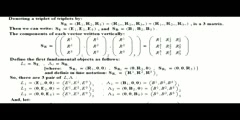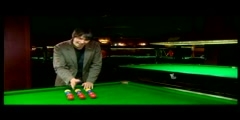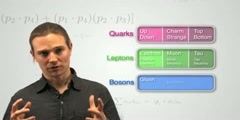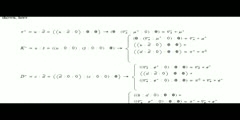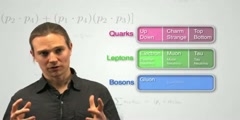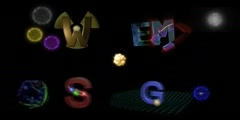The Standard Model Architecture and Interactions Part 2
This video is a second part of the standard model architecture and interactions. 2011 Claude Michael Cassano The Fermion Interaction: An interaction with entry ingredients A,B and exit ingredients C,D is denoted as you see, here: /n A+B → C+D/n which implies it's anti-equivalent. /n A fermion interaction is an interaction between first and second order objects, i.e.: between solitary S sub R matrices. The initial step in a fermion interaction proceess is fusion of two solitary S sub R matrices, enrty-wise, into a single S sub R matrix. Next, the S sub R matrix entries may flip between columns/generations with equal likelihood. The S sub R matrix entries may flip between rows/colors. Entries in the same column may flipas shown, here; or not with equal likelihood. These are the only random flip events conserving charge, so are the only ones allowed. Conservation of row/color indices, as detailed in the book, also restricts the possible flip events. Finally, the S sub R matrix separates into the two solitary matrices column resultants from the flip events occurring during the fusion. The first order objects (leptons) fermion-interactions oc cur as is shown, here. /n The neutrino - anti-electron interaction is shown, here, first; in complete detail. /n The electron - anti-electron interaction is shown, here, second; in complete detail. /n The neutrino - anti-neutrino interaction is shown, here, third; in complete detail. /n This is how the second order objects (quarks) are/were created from the most fundamental first order objects (leptons). /n Weak type interactions may be further classified according to whether they are of the form (1), or of the form of (2)/(3). /n Interactions of the form (1) are of the W type. Interactions of the form (2) or (3) are of the Z type. /n It will be seen that all the interactions to follow fall into these catagories. /n The second order objects (quarks) fermion-interactions are far more computationally long and intensive, but all the fermion-interactions may be summarized, as follows: /n No interaction has deterministic exit ingredients, but every interaction has a deterministic family of exit ingredients with probability outcome. /n All the interactions allow change of generation. /n The interactions are summarized, here. For the complete details of each interaction, refer to my book /n "a Mathematical Preon Foundation for the Standard Model" /n Thus, the above simple mathematical construction has just been clearly and concisely shown to define, analyze, and determine a foundation for the standard model with a simple interaction process consistent with experiment. /n That it is also completely, rigorously, exhaustively and irrefutably shown to define, analyze, and determine a foundation for the standard model with a simple interaction process consistent with experiment may be seen in my book, "a Mathematical Preon Foundation for the Standard Model", available on Kindle through amazon.com. /nFind links to all my books at the site listed at the bottom, here: http://www.amazon.com/-/e/B008MD6CVS .
Channels: Physics (General) Particle physics
Tags: standard model Klein-Gordon Equation electric field magnetic field quark lepton fermion particle physics
Uploaded by: cloudmichael ( Send Message ) on 08-04-2011.
Duration: 5m 26s
